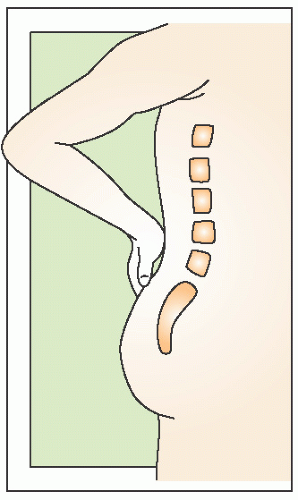Lumbosacral Strain
Eileen A. Crawford
Nader M. Hebela
CLINICAL PRESENTATION
Lumbosacral spine strain is an exceedingly common clinical entity experienced by nearly everyone at some point in their lives. The lower back consists of vertebrae connected to one another by a series of ligaments, both anteriorly and posteriorly. Both the vertebrae and the ligaments serve as attachments for muscles that traverse the entire dorsal aspect of the body from the neck to the sacrum and enable motion of the cervical, thoracic, and lumbosacral spine.
Lumbosacral strain occurs when there is an injury, either acutely or due to repetitive microtrauma, in the muscles, tendons, or ligaments of the lumbosacral spine. These small tears or stretching injuries cause inflammation and pain but do not destabilize the spine.1 Patients may present with an acute episode of trauma or a prolonged and persistent increase in the intensity and duration of their existing lower back pain. For instance, patients may report an immediate onset of lower back pain after a lifting injury or they may describe a consistently increasing pain in the lower back after repeated episodes of heavy lifting.
Patients typically describe pain emanating in a band-like distribution from a central region in the lumbosacral spine. The pain is exacerbated by movement. They may report tightness along the lumbosacral paraspinal muscle region. They describe pain in certain positions that is not necessarily consistent among different patients. One patient may describe pain with sitting while another describes pain with standing. Generally, however, there is a pattern to the pain that is either exacerbated or relieved by certain movements and positions.
Occasionally, patients may describe radicular pain into the gluteal region and rarely paresthesias that radiate into the lower extremity. Patients may describe weakness of the lower extremity that is almost always related to the pain they experience. In these cases, sitting often worsens the pain while standing, walking, or lying down helps to relieve the pain to some degree.
Patients who seek treatment for lumbosacral strain are generally young, between 20 and 50 years old. It is the most common cause of disability in patients <45 years old.1 Low back pain in an adolescent is unusual, however, and warrants further investigation to rule out more concerning diagnoses. Constitutional symptoms such as fever, night sweats, and unintentional weight loss are suggestive of infection or malignancy in both children and adults with low back pain.
CLINICAL POINTS
Lumbosacral spine strain is ubiquitous in the general population and a common cause of low back pain in patients 20 to 50 years old.
It may occur following an acute injury or as a subacute process with gradually worsening pain.
Stay updated, free articles. Join our Telegram channel

Full access? Get Clinical Tree








